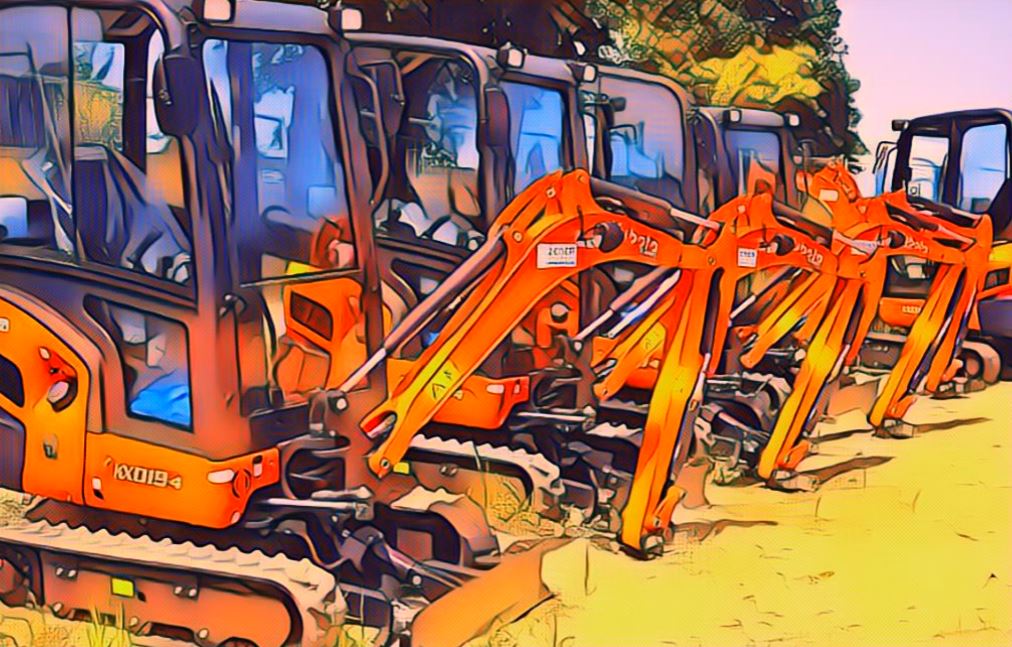Here at Startups #nofilter we get inquiries all the time about how to help struggling startups secure equipment financing especially when they have bad credit lines. No worries at all we are here to guide you! And here is our guide for equipment financing in New York City.
A quick disclaimer for 2024: we do not have personal experience with the equipment funding options listed below but rather we have reviewed and researched what is available for startup owners who have poor credit and are looking to finance new equipment purchasing, and below is what we found:

We wrote the guide below from the lens of an equipment financing loan officer who would be in charge of giving you your financing in light of your poor credit.
The 5 Steps for Securing Equipment Financing for a Bad Credit Startup:
-
Determine equipment needs and costs
- As a first step, make a detailed list of all the equipment you need to purchase and operate your business. This could include machinery, tools, furniture, technology, appliances, vehicles etc. Research the exact models and prices for each item. Common sources are equipment manufacturer/dealer websites or platforms like Alibaba. For example, a food truck startup might need:
- Food truck vehicle: $75,000 (https://g.co/kgs/cUfNYV)
- Cooking equipment: $15,000 (https://www.webstaurantstore.com)
- Point of sale system: $2,500 (https://www.squareup.com)
Total equipment purchase amount = $92,500
-
Explore financing options
- Next, research different equipment financing options like loans, leases and rent-to-own. Compare interest rates, payment timelines and overall costs offered by banks, credit unions, manufacturers and specialized lenders. For example, the food truck startup could find:
- 5 year equipment loan at 10% APR with 20% down payment
- True lease with option to buyout equipment after 3 year term
- Narrow down 2-3 financing offers for further evaluation
- Next, research different equipment financing options like loans, leases and rent-to-own. Compare interest rates, payment timelines and overall costs offered by banks, credit unions, manufacturers and specialized lenders. For example, the food truck startup could find:
-
Prepare documentation
- Lenders will require documents like your business plan, bank statements, tax returns, profit and loss statements, owner credit score and financial projections to approve financing. For startups less than 2 years old, provide detailed 12-24 month projections showing ability to make payments.
-
10 documents checklist for securing startup equipment financing for your bad credit startup:
- Business plan https://www.sba.gov/business-guide/plan-your-business/write-your-business-plan
- Previous year’s business tax returns (if in operation) https://www.irs.gov/businesses/small-businesses-self-employed/filing-business-tax-returns
- Year-to-date profit & loss statement https://bench.co/blog/accounting/profit-and-loss-statement/
- 12 to 24 month cash flow projection https://www.nolo.com/legal-encyclopedia/creating-cash-flow-projection.html
- Personal financial statement https://www.sba.gov/funding-programs/surety-bonds/prepare-financial-statements
- Personal tax returns for past 1-2 years https://www.irs.gov/forms-pubs/about-form-1040
- Resumes of owners and key employees https://www.thebalancecareers.com/what-to-include-in-a-resume-2061988
- Business debt schedule (if applicable) https://smallbusiness.chron.com/list-business-debts-business-plan-25239.html
- Cost quotes & details for equipment purchases
https://www.nfib.com/content/advisory/capital/equipment-financing-options-for-small-businesses/ - Owners’ personal credit reports from major credit bureaus https://www.consumer.ftc.gov/articles/0155-free-credit-reports
-
Apply and seek financing terms
- With all documentation ready, fill out loan or lease applications with your selected lenders. Negotiate for the best possible rates, fees and repayment terms tailored to your expected cash flows before signing any agreement.
-
Prepare business information documents: (Checklist)
- Business plan (https://www.sba.gov/business-guide/plan-your-business/write-your-business-plan)
- Articles of incorporation & bylaws (https://www.upcounsel.com/articles-of-incorporation-and-bylaws)
- EIN/TIN for business tax purposes (https://www.irs.gov/businesses/small-businesses-self-employed/apply-for-an-employer-identification-number-ein-online)
- Prepare historical and projected financial statements
- 3 years of business tax returns (https://www.irs.gov/filing)
- Current year-to-date profit & loss statement (https://www.wallstreetmojo.com/profit-and-loss-statement/)
- Balance sheet for current period (https://www.investopedia.com/terms/b/balancesheet.asp)
- 2 years of detailed monthly cash flow projections (https://www.business.gov.au/planning/business-plans/cash-flow-projections-template)
- Gather personal financial documents
- Personal tax returns for past 3 years (https://www.irs.gov/filing)
- Personal financial statements/balance sheets (https://bizfluent.com/how-2154019-prepare-personal-financial-statement.html)
- Personal credit reports from major bureaus (https://www.usa.gov/credit-reports)
- Prepare equipment loan/lease application package
- Equipment quotes & details on what will be financed (https://www.fundera.com/business-loans/guides/equipment-financing)
- Loan or lease application forms required by lenders (https://www.kabbage.com/funding/qualify-for-loan/)
- Explanations for late payments or credit issues (https://www.experian.com/blogs/ask-experian/credit-education/faqs/what-is-a-personal-statement-of-explanation/)
- Collateral details – equipment acts as collateral typically (https://www.businessknowhow.com/financing/collateral.htm)
-
Accept funding and purchase equipment
- Finally the lender will fund the lease, loan or other financing instrument for your business to move ahead with acquiring the essential equipment. Coordinate delivery and setup, making sure everything aligns with your original plans.
- Review and accept loan/lease terms
- Carefully verify that the interest rates, fees, repayment period and all terms match what you had requested and expected from the financing company.
- Consult your accountant or financial advisor if you have any doubts before signing the final loan or lease paperwork.
- Source: https://www.fundera.com/business-loans/guides/small-business-equipment-loans
- Plan equipment procurement
- Develop a detailed inventory of each piece of equipment you plan to purchase along with supplier details, costs, delivery timelines etc.
- Proper planning ensures you purchase equipment that meets technical needs and integrates well with other systems.
- Source: https://www.netsuite.com/portal/resource/articles/financial-management/equipment-financing-for-small-businesses.shtml
- Place equipment orders
- After financing is secured, place purchase orders for all equipment per your finalized procurement plan.
- Make sure to coordinate delivery dates across suppliers and have storage space ready if needed.
- Have staff assigned to track orders and deliveries for each piece of equipment.
- Source: https://www.thehartford.com/business-playbook/in-depth/equipment-leasing-and-financing
According to the Equipment Leasing and Finance Foundation, in 2021 ~80% of U.S. companies used equipment financing allowing them to start and expand operations. Following these best practice tips and steps can help ensure your startup’s success in securing necessary funding. Please let me know if you need any clarification or have additional questions!
3 Interesting Statistics Related to Equipment Financing for Startups:
- In 2021, $898 billion was invested globally in equipment leasing and financing
- 72% of U.S small businesses use some form of financing for equipment purchases
- Top industries using equipment financing include agriculture (46%), construction (45%), transportation (25%).
What are the Risks with Bad Credit Equipment Financing for Startups?
There are big time risks associated with trying to secure equipment financing with poor credit history – no matter what startup niche you are in!
- Low credit score leads to denial for financing
- According to Fundera research, only 18% of equipment financing applications get approved if the business owner has a credit score below 550.
- Source: https://www.fundera.com/resources/equipment-financing-statistics
- Higher interest rates
- Firms with below 600 credit scores pay 3-4% higher interest on average for equipment financing compared to those over 750 score as per a Federal Reserve study.
- Source: https://www.federalreserve.gov/pubs/feds/2020/2020052/2020052pap.pdf
- Shorter repayment terms
- On average, high risk applicants get 12-18 month repayment terms for equipment loans compared to 36-60 months for those with 700+ scores as per LendingTree analysis.
- Tighter repayment periods lead to unaffordable high monthly dues.
- Source: https://www.lendingtree.com/business/small/bad-credit-business-loans/
The main alternatives to avoid these financing risk with poor credit include:
- Improving personal credit rating over 6-12 month period before applying
- Making large down payments above 50% to demonstrate commitment
- Seeking a cosigner with better credit to support the application
What Advice Would an Equipment Financing Loan Officer Give to You, a Startup Founder with Poor Credit?
This one of the most common questions we see in 2024 and the answer is of course subjective. But here goes nothing:
- Work on Improving Your Credit Score: While it may take time, focus on improving your credit score. Pay off any outstanding debts, make payments on time, and work on reducing your credit utilization ratio.
- Consider Alternative Lenders: Traditional banks may be hesitant to lend to someone with poor credit, but there are alternative lenders who specialize in working with startups in similar equipment need situations. They may be more flexible in their lending criteria.
- Offer Collateral or a Personal Guarantee: Providing collateral, such as equipment or property, can help mitigate the risk for the lender – but dangerous! Alternatively, you could offer a personal guarantee, which means you are personally responsible for repaying the startup equipment loan if your business is unable to.
- Look for Equipment Financing Specialists: Some lenders specialize in startup equipment financing and may be more willing to overlook poor credit if they see the equipment you’re purchasing as valuable collateral.
- Prepare a Strong Business Plan: A well-thought-out business plan can demonstrate to lenders that your startup business is viable and has the potential to generate enough revenue to repay the loan, even with your bad credit situation.

Editor of Startups #nofilter


